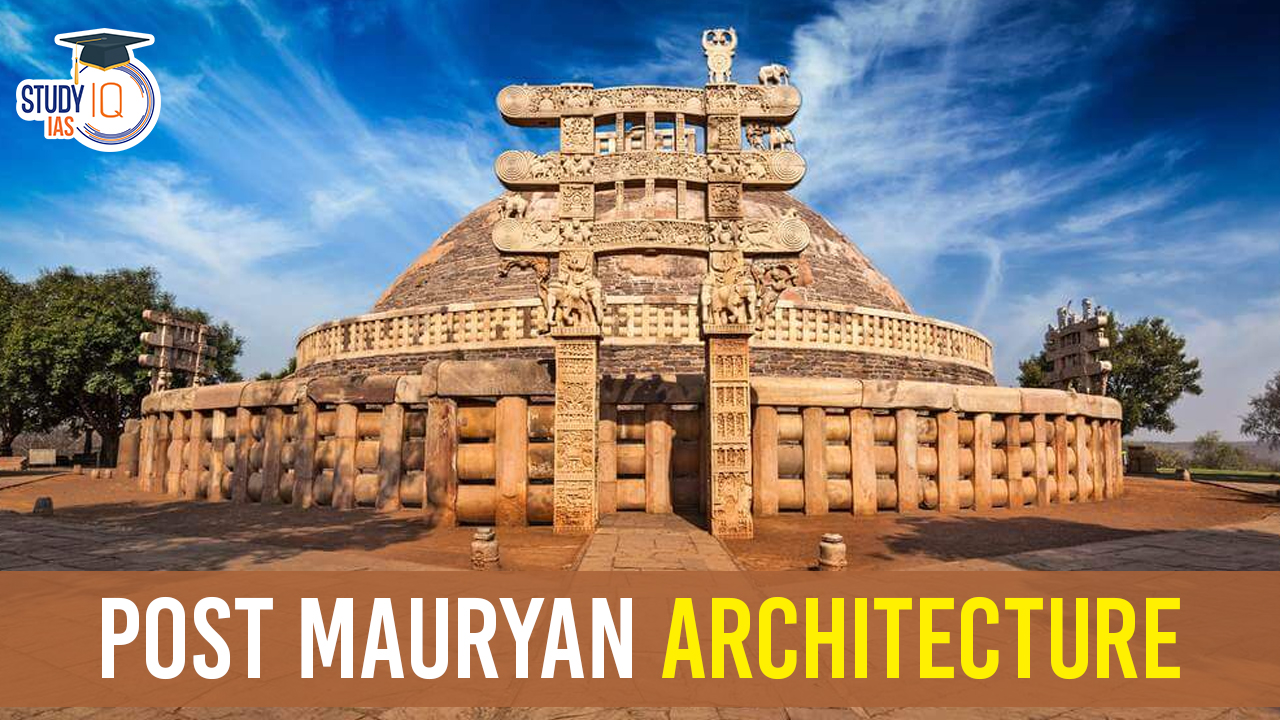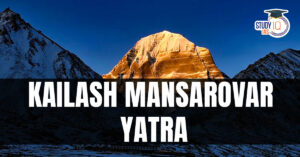Table of Contents
Post-Mauryan architecture in ancient India refers to the architectural developments that took place after the decline of the Mauryan Empire, which lasted from approximately 322 BCE to 185 BCE. The Mauryan Empire, under the rule of Chandragupta Maurya and later his grandson Ashoka, saw significant advancements in architecture, particularly with the construction of the famous Ashoka pillars and the rock-cut caves.
We’re now on WhatsApp. Click to Join
Post Mauryan Architecture
During the period from the second century BCE onwards, various rulers exerted control over the expansive Mauryan Empire. In the northern and central regions, the Shungas, Kanvas, Kushanas, and Guptas held sway, while in the southern and western parts, the Satvahanas, Ikshavakus, Abhiras, and Vakataks established their dominance. Concurrently, the second century BCE witnessed the ascendancy of major Brahmanical sects like the Vaishnavas and the Shaivas. Numerous archaeological sites dating back to this era dot the Indian landscape, showcasing exquisite sculptures at locations such as Vidisha, Bharhut (Madhya Pradesh), Bodhgaya (Bihar), Jaggayyapeta (Andhra Pradesh), Mathura (Uttar Pradesh), Khandagiri-Udaigiri (Odisha), Bhaja near Pune, and Pavani near Nagpur (Maharashtra).
Post-Mauryan Trends in Indian Art and Architecture
From the 2nd century BCE onward, control over the extensive Mauryan Empire shifted among rulers like the Shungas, Kanvas, Kushanas, and Guptas in the north, and the Satavahanas, Ikshavakus, Abhiras, and Vatakas in the south and west. Concurrently, the rise of major Brahmanical sects, including the Vaishnavas and Shaivas, marked this era. Notably, post-Mauryan trends showcased exceptional sculptures at locations like Vidisha, Bharhut (M.P), Bodhgaya (Bihar), Jaggaypetta (Andhra Pradesh), Mathura (UP), Khandagiri-Udayagiri (Odisha), and Bhaja near Pune (Maharashtra).
| eriod | Characteristics | Examples |
| Buddhist Caves (2nd Century BCE Onwards) | Apsidal vault-roof chaitya halls – Apsidal vault-roof pillarless halls – Flat-roofed quadrangular halls with a circular chamber – Stupas at the back of chaitya caves | Ajanta, Pitalkhora, Bhaja, Thana-Nadsur, Kondivite, Karla, Kanheri |
| Modifications in Chaitya Halls (1st Century BCE) | Rectangular halls added to the standard apsidal vault-roof variety | Ajanta Cave No. 9, Karla Cave (Unfinished), Bedsa, Nashik, Kanheri |
| Viharas in Cave Sites | Veranda, hall, cells around walls – Interior decorative motifs like chaitya arches – Nashik vihara caves with front pillars carved with ghata-base and ghata-capital | Ajanta Cave No. 12, Bedsa Cave No. 11, Nashik Cave Nos. 3, 10, 17 |
| Largest Cave Excavations | Karla (rock-cut chaitya hall) – Junnar (Ganeshleni, later transformed into a chaityavihara) | Karla, Junnar |
| Prominent Cave Sites | Ajanta, Pitalkhora, Ellora, Nashik, Bhaja, Junnar, Karla, Kanheri | Ajanta, Ellora, Kanheri |
| Ajanta Caves | Chaitya caves datable to 2nd and 1st century BCE – Large chaityaviharas with sculptures and paintings – Survival of paintings from 1st century BCE to 5th century CE | Caves Nos. 10, 9, 12, 13, 11, 15, 6, 7, 19, 26 |
| Ajanta Cave Paintings | Typological variations – Rhythmic lines and expressions – Naturalistic postures – Depiction of Buddha’s life, Jatakas, and Avadanas | Cave Nos. 1, 2, 16, 17, paintings in early phases (Caves 9, 10) |
| Ellora Caves | Unique art-historical site with monasteries of Buddhism, Hinduism, and Jainism – Triple storeyed caves – Sculptures show slenderness | Cave No. 16 (Kailash Temple), Caves 29, 21 (Shaivite), Cave No. 14 (Brahmanical) |
| Terracotta Figurines | Found all over the country – Toys, religious figurines, and for healing purposes | Examples found at various archaeological sites |
Bharhut
The sculptures at Bharhut, reminiscent of Mauryan images of Yaksha and Yakshini, are characterized by their towering presence. Sculptural volume is executed in low relief, maintaining linearity, and the images adhere closely to the picture plane. Narrative panels at Bharhut employ tilted perspective to create an illusion of three-dimensionality, enhancing the clarity of the depicted stories. Over time, narrative panels evolve to include more characters, moving beyond the main protagonist. The utilization of space is maximized, with folded hands and flat figures depicting Yakhshas and Yakshinis. As carving techniques progress, images at Bharhut, along with those at Bodhgaya, Sanchi Stupa-2, and Jagayyapetta, exemplify deep carvings, pronounced volume, and a naturalistic representation of human and animal bodies.
Narrative reliefs at Bharhut effectively convey stories through pictorial language. Notably, a depiction of Queen Mayadevi’s dream features a descending elephant symbolically moving towards her womb. Jataka stories are presented with simplicity, often grouping events based on geographical locations. Such stories, including the Ruru Jataka, became integral to stupa decoration. Regional stylistic variations emerge with the construction of stupas across the country, and a distinct characteristic in male images of the first and second centuries BCE is the knotted headgear.
Sanchi
The sculptural development at Sanchi Stupa-1, Mathura, and Vengi in Andhra Pradesh during the next phase reflects significant stylistic progression. Sanchi Stupa-1 features both upper and lower circumambulatory paths, with beautifully decorated toranas illustrating events from Buddha’s life and Jatakas. Figure compositions, in high relief, exhibit naturalistic postures, eliminating stiffness. Heads project prominently, adding dynamism to the images. Carving techniques at Sanchi are more advanced than Bharhut, with elaborate narration and the continued use of symbols representing the Buddha.
Sanchi Stupa-1’s narratives delve into historical events with intricate details, including the siege of Kushinara, Buddha’s visit to Kapilavastu, and Ashoka’s pilgrimage to the Ramgrama Stupa. In Mathura, contemporary images display similar quality but differ in the depiction of physiognomic details. The overall sculptural landscape at Sanchi reflects a refinement and sophistication in carving techniques, marking a significant advancement from earlier periods.
Mathura, Sarnath and Gandhara Schools
From the 1st century CE onward, Gandhara (now in Pakistan), Mathura in northern India, and Vengi in Andhra Pradesh emerged as pivotal hubs of art production.
Mathura School
In the city of Mathura, the sculptural tradition underwent significant evolution from the 1st century CE onward. Here, the symbolic representation of Buddha transitioned into a human form, largely influenced by the local Yaksha tradition. Bold carving techniques, round and smiling faces, and garments covering the left shoulder were characteristic features. Mathura emerged as a major art production center, fostering a diverse range of sculptures, including representations of Vaishnava and Shaiva deities alongside Buddhist images. The sculptural style in Mathura witnessed a transformation from the 2nd to the 6th centuries CE, with a notable refinement in the integration of drapery and a shift towards a more transparent quality.
Sarnath School
Sarnath, situated in northern India, became another significant center for sculptural production during this period. Notable for its unique stylistic elements, Buddha images in Sarnath featured plain transparent drapery covering both shoulders. Halos around the heads were minimally ornamented, distinguishing them from their counterparts in Mathura. The school in Sarnath contributed to the rich diversity of sculptural traditions in northern India, offering a different aesthetic sensibility from the Mathura School.
Gandhara School
In the region of Gandhara, located in present-day Pakistan, a distinctive sculptural tradition emerged as a result of the confluence of Bactrian, Parthian, and local influences. The Buddha image in Gandhara showcased Hellenistic features, setting it apart from the traditional Yaksha-inspired representations in Mathura. The school in Gandhara reflected a fusion of diverse cultural elements, creating a unique artistic legacy. Noteworthy for its cultural confluence, Gandhara’s sculptural tradition made a lasting impact on the artistic landscape of the region.
Buddhist Monuments of South India
Vengi’s Stupa Sites
- Locations: Jagayyapetta, Amaravati, Bhattiprolu, Nagarjunkonda, Goli.
- Amaravati’s mahachaitya features a unique domical stupa with relief sculptural slabs.
- Construction activity spans from the 3rd century BCE, reaching its peak in the 1st and 2nd centuries CE.
Amaravati Sculptures
- Characteristics: Intense emotions, slender figures, complex movement.
- Three-dimensional space achieved through pronounced volume and overlapping.
- Narrative richness includes events from Buddha’s life and Jataka stories.
- Independent Buddha images emerge in Amaravati, Nagarjunkonda, and Guntapalle.
Evolution and Regional Styles
- Third-century CE sees a reduction in animated movement in Nagarjunkonda and Goli.
- Amaravati’s influence extends to rock-cut stupas in Anakapalle and Sannati (Karnataka).
- Amaravati’s impact visible in structured temples, viharas, and chaityas.
- Bodhisattva sculptures gain prominence, reflecting an evolving sculptural tradition.
- Rise of Vajrayana Buddhism introduces personified representations, expanding Buddhist principles for societal welfare.
Cave Tradition in Western India
- Excavated from the second century BCE onwards.
- Three main architectural types: apsidal vault-roof chaitya halls, apsidal vault-roof pillarless halls, and flat-roofed quadrangular halls with a circular chamber at the back.
- Examples include Ajanta, Pitalkhora, Bhaja, Thana-Nadsur, and Kondivite.
Evolution of Chaitya Halls
- Modifications in the first century BCE, with some halls becoming rectangular (e.g., Ajanta Cave No. 9).
- Karla chaitya hall is significant, with an open courtyard, pillars, stone-screen walls, and a stupa at the back.
- Quadrangular flat-roofed variety became popular in subsequent periods.
Viharas in Cave Sites
- Viharas consist of a veranda, a hall, and cells around the walls.
- Examples include Ajanta Cave No. 12, Bedsa Cave No. 11, Nashik Cave Nos. 3, 10, and 17.
- Nashik viharas are known for front pillars carved with ghata-base and ghata-capital with human figures.
Significant Cave Sites
- Important cave sites include Ajanta, Pitalkhora, Ellora, Nashik, Bhaja, Junnar, Karla, and Kanheri.
- Ajanta is renowned for its chaitya caves and large chaityaviharas with sculptures and paintings.
- Ajanta Caves:
- Located in Aurangabad District, Maharashtra.
- Twenty-nine caves with chaitya caves datable to the second and first century BCE and the fifth century CE.
- Paintings in Ajanta depict events from the life of Buddha, Jatakas, and Avadanas.
- Paintings show typological variations, rhythmic lines, and heavy figures.
- Ellora Caves:
- Located in Aurangabad District, Maharashtra, with thirty-four caves associated with Buddhism, Brahmanism, and Jainism.
- Stylistic eclecticism with sculptures depicting Vajrayana Buddhism, Shaivism, and Vaishnavism.
- Cave No. 16 (Kailash leni) is a unique rock-cut temple carved from a single rock.
- Other Cave Sites:
- Bagh Caves in Madhya Pradesh with Buddhist mural paintings.
- Elephanta Caves near Mumbai dedicated to Shaivism.
- Rock-cut caves in Karnataka (Badami and Aiholi), Andhra Pradesh, and Tamil Nadu.
Terracotta Figurines
- Found nationwide, representing a parallel tradition with religious lithic sculptures.
- Varied sizes used as toys, religious figurines, and for healing purposes.
- Reflects both the religious and local traditions.
Cave Tradition in Eastern India
- Mainly found in the coastal region of Andhra Pradesh and in Odisha.
- Notable site in Andhra Pradesh: Guntapalle in Eluru district.
- Guntapalle features structured stupas, viharas, and caves excavated in one place.
- Chaitya cave at Guntapalle is circular with a stupa in the hall and a chaitya arch at the entrance.
Guntapalle Caves
- Relatively small compared to western Indian caves.
- Vihara caves, despite small dimensions, decorated with chaitya arches on the exterior.
- Date back to the second century BCE.
- Some later additions, all of the vihara type.
Rampaerrampallam
- Another important cave site in Andhra Pradesh.
- Features moderate small excavations and rock-cut stupas on the hillock.
Anakapalli
- Near Vishakhapatnam.
- Caves excavated with a huge rock-cut stupa during the fourth–fifth centuries CE.
- Unique for having the biggest rock-cut stupas in the country.
- Votive rock-cut stupas surrounding the hillock.
Cave Tradition in Odisha
- Udaigiri-Khandagiri caves near Bhubaneswar in Odisha.
- Early examples with inscriptions of Kharavela Jain kings.
- Meant for Jain monks, featuring numerous single-cell excavations.
- Some carved in huge independent boulders shaped like animals.
- Big caves include a pillared veranda with cells at the back, decorated with chaitya arches.
Overall Characteristics
- Existence of rock-cut cave tradition in eastern India.
- Unique sites with structured stupas, viharas, and caves excavated together.
- Presence of both chaitya and vihara types, with variations in size and architectural elements.
Characteristics of Different Architectural Schools
Mathura School of Sculpture
- Example: Seated Buddha from Katra Mount (2nd century CE).
- Characteristics:
- Represents Buddha with two Boddhisattva attendants.
- Seated in Padmasana with the right hand in Abhayamudra.
- Round face with fleshy cheeks.
- Ushanisha shown with a vertical raised projection.
- Sculptures have light volume and a fleshy body.
- Sanghati (garment) covers only one shoulder.
- Large halo decorated with simple geometric motifs.
Sarnath School of Sculpture
- Example: Seated Buddha at Sarnath (Late 5th century CE).
- Characteristics:
- Buddha seated on a throne in Padmasana.
- Depicts Dhammachakrapravartana (first sermon) with figures on the throne.
- Panel below the throne represents a Chakra (wheel) and deer, symbolizing the preaching of dhamma.
- Round face with half-closed eyes, protruding lower lip.
- Hands in Dhammachakrapravartana Mudra.
- Circular curled hair in Ushanisha.
- Represents the historic event of Dhammachakrapravartana.
Gandhara School of Sculpture
- Example: Buddha Head from Taxila (2nd century CE).
- Characteristics:
- Hybridized with Greek and Roman elements.
- Curly, thick hair with covered layer and linear strokes.
- Large forehead plane, half-closed eyes, not round face.
- Ears are elongated, exhibiting heaviness.
- Linearity in form with sharp outlines.
- Smooth surface, expressive, calm expression.
- Assimilation of Acamenian, Parthian, and Bactrian traditions.
- Geopolitical conditions influenced the style.
Amaravati Stupa Sculpture
- Example: Amaravati Stupa, Andhra Pradesh.
- Characteristics:
- Similar to Sanchi with pradakshinapatha and vedika.
- Domical stupa covered with relief stupa sculpture slab.
- Torana (gateway) has disappeared over time.
- Intense emotions depicted, bodies with three bends (Tribanga).
- Complex sculpture composition.
- Buddha images added in the later phase (2nd and 3rd CE).
- The Dream of Queen Mayadevi and other narratives depicted.
- Independent Buddha images found at Amaravati, Nagarjunakonda, and Guntapalle.
Overall Observations
- Evolution of styles over different periods and regions.
- Mathura known for fleshy sculptures with light volume.
- Sarnath showcases historical events in sculpture.
- Gandhara reflects hybridization with Western elements.
- Amaravati features intense emotions and complex compositions.
- Diverse representations influenced by geopolitical conditions and cultural assimilation.
Post Mauryan: Early Temples in Ancient India
During this era, alongside the continued construction of stupas, the emergence of Brahmanical temples marked a significant shift. Temples began incorporating narratives from Puranic myths, and each temple featured a principal deity.
Key Characteristics of Temple Shrines
Sandhara Type:
- Description: Includes a pradakshinapatha (circumambulatory path).
- Purpose: Allows devotees to perform circumambulation around the principal deity.
Nirandara Type:
- Description: Lacks a pradakshinapatha.
- Purpose: Design simplification without the circumambulatory path.
Sarvatobhadra Type:
- Description: Accessible from all sides.
- Purpose: Offers flexibility in temple access, symbolizing openness.
Notable Temple Sites
Deogarh (Uttar Pradesh):
- Significance: Represents the Sandhara type temple with a pradakshinapatha.
- Features: Integration of Puranic narratives in temple architecture.
Eran, Nacha-kuthara (Madhya Pradesh):
- Features: Examples of early temples showcasing different shrine types.
- Cultural Significance: Reflects the diversity in temple architecture during this period.
Udayagiri near Vidisha (Madhya Pradesh):
- Characteristics: Houses temples with diverse shrine types, showcasing architectural experimentation.
- Artistic Elements: Incorporation of Puranic myths in temple narratives.
Post Mauryan Architecture UPSC
Post-Mauryan architecture witnessed the evolution of Buddhist cave complexes in Western India, notably at Ajanta, Ellora, and Kanheri, featuring chaitya halls and viharas. Modifications included rectangular halls and the prevalence of flat-roofed quadrangular designs. The Ellora complex, a unique confluence of Buddhism, Hinduism, and Jainism, showcased triple-storeyed caves. Ajanta’s famed paintings, spanning from the 2nd century BCE to the 5th century CE, stand as a testament to artistic achievement. Terracotta figurines, found nationwide, reflected diverse uses. The architectural trends underscored the cultural dynamism and religious pluralism characterizing ancient Indian societies in the post-Mauryan period.


 Golconda Blue Diamond, a Rare Gem from I...
Golconda Blue Diamond, a Rare Gem from I...
 Kailash Mansarovar Yatra to Resume Soon,...
Kailash Mansarovar Yatra to Resume Soon,...
 Bihu Festival and Dance of Assam, Histor...
Bihu Festival and Dance of Assam, Histor...





















